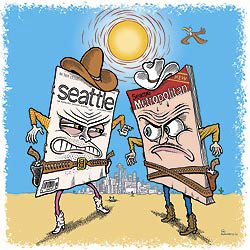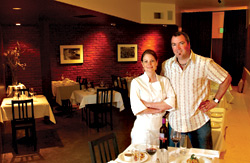Seattle is no stranger to newspaper wars, but what would a magazine war look like? It’s hard to imagine, because the city’s dominant slick, Seattle, hasn’t had serious competition (besides the specialized Seattle Homes & Lifestyles) since its inception. That unchallenged streak will end when Seattle Metropolitan magazine launches in March. But to hear the top people at both publications tell it, the skirmish might begin with more of a whimper than a bang.
Seattle Metropolitan will be Nicole Vogel’s foray into Seattle. The erstwhile CNN vice president started Portland Monthly with her brother, Scott Vogel, in October 2003. Eighteen months later, it had won three City and Regional Magazine Association awards. According to Vogel, Portland Monthly‘s circulation is approximately 56,000. In a city that has long resembled Teflon for local magazines,Vogel’s venture has stuck. She hopes to apply a similar formula here with similar results.
In the other corner, meanwhile, we have Seattle, founded as Pacific Search by King Broadcasting matriarch Harriett Bullitt in 1966. According to Rachel Hart, the magazine’s editor since 1999, the title has gone through several major changes, the most recent of which—its 1999 acquisition by Minneapolis-based Tiger Oak Publications—was probably the biggest. Hart says the purchase led to Seattle becoming less tourist-oriented and “pulled it out of financial despair.” It also helped boost paid circulation to the current total average of 39,261. Hart says no further changes are planned to coincide with Metropolitan‘s arrival, though she admits the magazines will share a lot of editorial turf.
Maybe so, but judging from Vogel’s Portland Monthly, the way each publication treads on that turf will be very much its own. Vogel cites Portland Monthly‘s wit—she calls it “laugh-with-you humor, not laugh-at-you humor”—as one of its strengths, which means we’re likely to see it in the pages of Seattle Metropolitan, too. One example: “When Trends Attack,” in the November 2004 Monthly, pokes self-deprecating fun at the lag between a trend’s emergence in New York and its arrival—half a decade later—in Portland. (Portland Monthly also includes serious reporting; the same issue has a story about Pulitzer Prize–winning Willamette Week writer Nigel Jaquiss.) Seattle, in contrast,mostly plays it straight. “The Power 25” (profiles of influential Puget Sounders) and a photo essay on local soldiers with Gulf War experience appear in the November issue. Similarly, a 2002 feature called “Divine Secrets of Seattle’s Debutantes” treated the subject with minimal irony.
If Seattle and Seattle Metropolitan bring very different voices and attitudes to similar material, maybe they can share the city, after all. “I’m not coming into this market saying, ‘I have to fight Seattle magazine,'” Vogel says, adding that Metropolitan should appeal to a younger, somewhat less affluent, less female-skewing readership. Seattle‘s associate publisher, Melissa Coffman, says the newcomer might resemble “Seattle Weekly in Seattle magazine clothing.” Which begs the question: Could the two co-exist peacefully? Not likely, says Willamette Week Publisher Richard Meeker. “If you’re in the slick magazine business, how can it not be head to head?” he says. “Does Seattle Weekly not go head to head with The Stranger?” (The answer, as you can probably see for yourself, is yes in some ways, no in others.) Yet Meeker insists there’s a big difference between a newspaper war and a magazine war; the former, he says, is about “which one’s the must-read,” while the latter has more to do with “which one’s the must-have-on-the-coffee-table.”
David Brewster, who worked as a writer for an unrelated magazine also called Seattle (1964–70) before founding Seattle Weekly in 1976, feels that Seattle Metropolitan may well become a viable contender, due in part to “a nonpolitical style that straddles the urban/suburban gulf.” For him, Metropolitan‘s arrival is in alignment with national and local trends. The current prosperity of city magazines across the country dovetails, he says, with “a much more full-throated embrace of quality goods, fashion, expensive restaurants, and the like” than has existed in Seattle. Maybe he’s onto something. While it’s hard to predict how the two magazines will behave or evolve during the coming conflict, perhaps the fact there is a battle, not how it’s waged, tells something important about the city.








